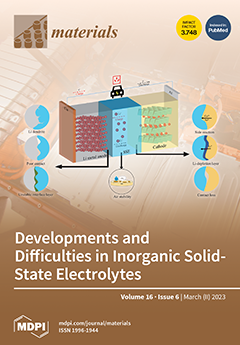In this study, silicone rubber (SiR) with 0, 90, and 180 parts of aluminum hydroxide (Al(OH)
3, ATH) contents prepared in the laboratory was treated in a certain concentration of NO
2 for 0, 12, 24, and 36 h. Fourier transform-infrared spectroscopy
[...] Read more.
In this study, silicone rubber (SiR) with 0, 90, and 180 parts of aluminum hydroxide (Al(OH)
3, ATH) contents prepared in the laboratory was treated in a certain concentration of NO
2 for 0, 12, 24, and 36 h. Fourier transform-infrared spectroscopy (FT-IR), scanning electron microscopy (SEM), atomic force microscopy (AFM), X-ray photoelectron spectroscopy (XPS), and thermogravimetry (TG) were used to study the changes in the surface structure and thermal stability of SiR, as well as the influence of Al(OH)
3 on the properties of SiR. According to AFM, the root-mean-square roughness of ATH-90 SiR was 192 nm, which was 2.7 times of ATH-0 SiR. With the incorporation of ATH, the surface of SiR became more susceptible to corrosion by NO
2. According to FT-IR and XPS, with the increase in aging time, the side chain Si-CH
3 of polydimethylsiloxane (PDMS) was oxidized gradually and a few of nitroso -NO
2 groups were formed. According to TG, the incorporation of ATH caused the maximum decomposition rate temperature of PDMS to advance from 458.65 °C to 449.37 and 449.26 °C, which shows that the thermal stability of SiR degraded by adding ATH. After NO
2 aging, a new decomposition stage appeared between 75 and 220 °C (stage Ⅰ), and this decomposition trend was similar to aluminum nitrate, which was proven to reduce the thermal stability of PDMS. The effects of NO
2 on the surface structure and thermal stability of different ATH contents of silicone rubber were preliminarily clarified by a variety of characterization methods, which provided ideas for the development of silicone rubber resistant to NO
2 aging.
Full article






